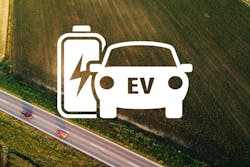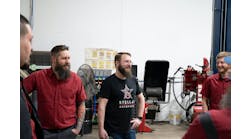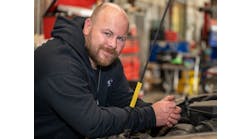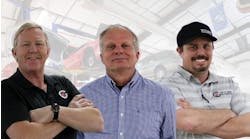The market for electric vehicles (EVs) in America is gaining traction, with analysts expecting 3 million EVs on the road in the next five years, according to a new study "EVs and EDs: Rural electric coops to benefit from the late adoption of electric vehicles." The same study examines why many rural auto repair shops have failed to invest in EV and hybrid training required to properly repair those vehicles: Drivers in rural areas aren’t adapting to the trend—and won’t for at least the next 10 years.
But Larry Johnson, owner of Johnson Automotive in Faribury, Ill., isn’t deterred by that reality. In fact, Johnson has invested over $10,000 in EV training classes and an electric vehicle charger at his hybrid and EV focused shop. Even though the market is low, he plans on obtaining 100 percent of his investment while competing rural shops carry on.
According to “EVs and EDs: Rural electric coops to benefit from late adoption of electric vehicles,” EVs accounted for 3 percent of monthly car sales in September 2017. But the majority of these, through 2025, will remain in cities and urban communities. The limited demand in rural communities is mostly driven by range anxiety associated with electric vehicles’ batteries.
A recent Lang Aftermarket report showed that plug-in electric vehicles presently represent just 1.2 percent of the new vehicle market, and will not pose a major threat to aftermarket product volume until 2030. This doesn’t mean it can’t be a revenue stream as EV technology gets better and better—many shop owners may neglect this opportunity, which can create an opening for your shop.
Johnson has turned to EV repair training and battery charging as a way to get ahead of the EV curve. While EV adoption is low in his area (and many others), he points to many components of this study to show that any rural repair shop can use EVs as an effective marketing tool and get ahead of the impending mass adoption of EVs.
“I see a need in the present and in the future,” Johnson. “You want somebody else to be the first guy out there, or are you going to be the first guy out there?”
Why EV Adoption is Slow
The study was released in December through CoBank, a cooperative bank service serving industries across rural America. The rural areas that the study looked at were counties at or below the 50,000 population level.
Though the statistics for rural adoption of EVs look bleak, with analysts expecting penetration to remain below 1 percent through 2025, CoBank economist Taylor Gunn says these areas should eventually adopt EVs.
“I think eventually the rural communities will see an uptick and higher adoption rates of electric vehicles,” Gunn says. “But I don’t think it’ll be in the next five years or even the next 10 years. I think it’ll be kind of a slow-go.”
To get to a point where adoption in rural communities takes off, Gunn says that three things need to happen.
1. Batteries must improve.
Gunn says that rural drivers need separate demands from regular commuters, and will need to drive longer distances between charges. Most EVs can drive up to 100 miles on a single charge, but that number is already trending upward.
“A lot of the main auto manufacturers have goals and have publicly stated that by 2020 there are going to be a lot of standard models out there that will easily have distances of 200 miles on a single charge,” Gunn says. “So I do think it’s going to become more commonplace.”
2. Price points must go down.
Even as EV battery life improves, the price point will still be out of range for most rural drivers, Gunn says.
“Even in 2020, if you do have vehicles that have a range of 200 miles, it’s still going to be more expensive than their internal combustion engine (ICE) counterparts,” he says.
Gunn quotes a study by Pacific Gas and Electric where the price premiums of electric pickup trucks, which should be available by 2020, will be $13,000 over ICE vehicles.
3. Charging stations must become more commonplace.
Studies of existing EV fleets show that 70-80 percent of charging is done at home. But with larger distances, rural drivers will need access to charging areas and ports.
As part of a major emissions scandal, Volkswagen is installing 2,800 EV charging stations throughout the U.S. Gunn says that these and other installation initiatives could benefit long distance travellers over the next several years.
“In my mind, the most immediate impact for these rural communities would be in high traffic, long-distance corridors,” Gunn says.
The Opportunity for Rural Shops
Johnson says that many drivers, dealers and repair shops in his area are skeptical about the growth of EVs, but he knows it’s an important avenue going forward. He compares it to the early days of fuel injection implementation—first people were skeptical in adopting it, and now every car has it.
He has the only EV charging station within 50 miles, which has exposed him to EV drivers throughout the state, and helps establish long-time customers. Non-customers can pay $8 per charging session, but customers can use it for free.
Johnson is changing the perception of his shop for when EVs become more mainstream. His technicians and service advisors are prepped to deal with Teslas and the variety of other EVs hitting the market, which he’s made part of his marketing and branding.
“If the perception is that I’ve been working on them for years, then customers are going to be much more comfortable coming to me for repairs,” Johnson says.
Though typical maintenance on electric cars is relegated to tire and brake work, Johnson says it’s important for both rural and urban shops to get a leg up on servicing them to prepare for the upcoming EV revolution, at whatever pace it’s coming.



